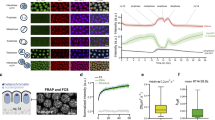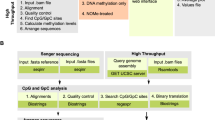Abstract
Regulatory machinery is focally organized in the interphase nucleus. The information contained in these focal nuclear microenvironments must be inherited during cell division to sustain physiologically responsive gene expression in progeny cells. Recent results suggest that focal mitotic retention of phenotypic transcription factors at promoters together with histone modifications and DNA methylation — a mechanism collectively known as gene bookmarking — is a novel parameter of inherited epigenetic control that sustains cellular identity after mitosis. The epigenetic signatures imposed by bookmarking poise genes for activation or suppression following mitosis. We discuss the implications of phenotypic transcription factor retention on mitotic chromosomes in biological control and disease.
This is a preview of subscription content, access via your institution
Access options
Subscribe to this journal
Receive 12 print issues and online access
$189.00 per year
only $15.75 per issue
Buy this article
- Purchase on Springer Link
- Instant access to full article PDF
Prices may be subject to local taxes which are calculated during checkout



Similar content being viewed by others
References
Urnov, F. D. & Wolffe, A. P. Above and within the genome: epigenetics past and present. J. Mammary Gland Biol. Neoplasia 6, 153–167 (2001).
Goldberg, A. D., Allis, C. D. & Bernstein, E. Epigenetics: a landscape takes shape. Cell 128, 635–638 (2007).
Berger, S. L. The complex language of chromatin regulation during transcription. Nature 447, 407–412 (2007).
Nelson, C. J., Santos-Rosa, H. & Kouzarides, T. Proline isomerization of histone H3 regulates lysine methylation and gene expression. Cell 126, 905–916 (2006).
Cuthbert, G. L. et al. Histone deimination antagonizes arginine methylation. Cell 118, 545–553 (2004).
Nathan, D. et al. Histone sumoylation is a negative regulator in Saccharomyces cerevisiae and shows dynamic interplay with positive-acting histone modifications. Genes Dev. 20, 966–976 (2006).
Shilatifard, A. Chromatin modifications by methylation and ubiquitination: implications in the regulation of gene expression. Annu. Rev. Biochem. 75, 243–269 (2006).
Nowak, S. J. & Corces, V. G. Phosphorylation of histone H3: a balancing act between chromosome condensation and transcriptional activation. Trends Genet. 20, 214–220 (2004).
Sterner, D. E. & Berger, S. L. Acetylation of histones and transcription-related factors. Microbiol. Mol. Biol. Rev. 64, 435–459 (2000).
Ruthenburg, A. J., Li, H., Patel, D. J. & Allis, C. D. Multivalent engagement of chromatin modifications by linked binding modules. Nature Rev. Mol. Cell Biol. 8, 983–994 (2007).
Trojer, P. & Reinberg, D. Histone lysine demethylases and their impact on epigenetics. Cell 125, 213–217 (2006).
Jones, P. A. & Baylin, S. B. The epigenomics of cancer. Cell 128, 683–692 (2007).
Esteller, M. Epigenetics in cancer. N. Engl. J. Med. 358, 1148–1159 (2008).
Gal-Yam, E. N., Saito, Y., Egger, G. & Jones, P. A. Cancer epigenetics: modifications, screening, and therapy. Annu. Rev. Med. 59, 267–280 (2008).
Kouskouti, A. & Talianidis, I. Histone modifications defining active genes persist after transcriptional and mitotic inactivation. EMBO J. 24, 347–357 (2005).
Chow, C. M. et al. Variant histone H3.3 marks promoters of transcriptionally active genes during mammalian cell division. EMBO Rep. 6, 354–360 (2005).
Saurin, A. J. et al. The human polycomb group complex associates with pericentromeric heterochromatin to form a novel nuclear domain. J. Cell Biol. 142, 887–898 (1998).
Burke, L. J. et al. CTCF binding and higher order chromatin structure of the H19 locus are maintained in mitotic chromatin. EMBO J. 24, 3291–3300 (2005).
Sarge, K. D. & Park-Sarge, O. K. Mitotic bookmarking of formerly active genes: keeping epigenetic memories from fading. Cell Cycle 8, 818–823 (2009).
Martinez-Balbas, M. A., Dey, A., Rabindran, S. K., Ozato, K. & Wu, C. Displacement of sequence-specific transcription factors from mitotic chromatin. Cell 83, 29–38 (1995).
Groudine, M. & Weintraub, H. Propagation of globin DNAase I-hypersensitive sites in absence of factors required for induction: a possible mechanism for determination. Cell 30, 131–139 (1982).
Zeng, C. et al. Identification of a nuclear matrix targeting signal in the leukemia and bone-related AML/CBFα transcription factors. Proc. Natl Acad. Sci. USA 94, 6746–6751 (1997).
Ma, H., Siegel, A. J. & Berezney, R. Association of chromosome territories with the nuclear matrix. Disruption of human chromosome territories correlates with the release of a subset of nuclear matrix proteins. J. Cell Biol. 146, 531–542 (1999).
Verschure, P. J., van Der Kraan, I., Manders, E. M. & van Driel, R. Spatial relationship between transcription sites and chromosome territories. J. Cell Biol. 147, 13–24 (1999).
Nagaich, A. K. et al. Subnuclear trafficking and gene targeting by steroid receptors. Ann. N. Y. Acad. Sci. 1024, 213–220 (2004).
Misteli, T. The concept of self-organization in cellular architecture. J. Cell Biol. 155, 181–185 (2001).
Wagner, S., Chiosea, S. & Nickerson, J. A. The spatial targeting and nuclear matrix binding domains of SRm160. Proc. Natl Acad. Sci. USA 100, 3269–3274 (2003).
Choi, J.-Y. et al. Subnuclear targeting of Runx/Cbfa/AML factors is essential for tissue-specific differentiation during embryonic development. Proc. Natl Acad. Sci., USA 98, 8650–8655 (2001).
North, T. et al. Cbfa2 is required for the formation of intra-aortic hematopoietic clusters. Development 126, 2563–2575 (1999).
Spencer, C. A., Kruhlak, M. J., Jenkins, H. L., Sun, X. & Bazett-Jones, D. P. Mitotic transcription repression in vivo in the absence of nucleosomal chromatin condensation. J. Cell Biol. 150, 13–26 (2000).
He, S. & Davie, J. R. Sp1 and Sp3 foci distribution throughout mitosis. J. Cell Sci. 119, 1063–1070 (2006).
Pines, J. Mitosis: a matter of getting rid of the right protein at the right time. Trends Cell Biol. 16, 55–63 (2006).
Young, D. W. et al. Mitotic occupancy and lineage-specific transcriptional control of rRNA genes by Runx2. Nature 445, 442–446 (2007).
Young, D. W. et al. Mitotic retention of gene expression patterns by the cell fate determining transcription factor Runx2. Proc. Natl Acad. Sci. USA 104, 3189–3194 (2007).
Weintraub, H. et al. The myoD gene family: nodal point during specification of the muscle cell lineage. Science 251, 761–766 (1991).
Ali, S. A. et al. Phenotypic transcription factors epigenetically mediate cell growth control. Proc. Natl Acad. Sci. USA 105, 6632–6637 (2008).
Tang, Q. Q. & Lane, M. D. Activation and centromeric localization of CCAAT/enhancer-binding proteins during the mitotic clonal expansion of adipocyte differentiation. Genes Dev. 13, 2231–2241 (1999).
Xing, H. et al. Mechanism of hsp70i gene bookmarking. Science 307, 421–423 (2005).
Michelotti, E. F., Sanford, S. & Levens, D. Marking of active genes on mitotic chromosomes. Nature 388, 895–899 (1997).
Duncan, R. et al. A sequence-specific, single-strand binding protein activates the far upstream element of c-myc and defines a new DNA-binding motif. Genes Dev. 8, 465–480 (1994).
Michelotti, E. F., Michelotti, G. A., Aronsohn, A. I. & Levens, D. Heterogeneous nuclear ribonucleoprotein K is a transcription factor. Mol. Cell. Biol. 16, 2350–2360 (1996).
Michelotti, G. A. et al. Multiple single-stranded cis elements are associated with activated chromatin of the human c-myc gene in vivo. Mol. Cell. Biol. 16, 2656–2669 (1996).
Zaidi, S. K. et al. Nuclear microenvironments in biological control and cancer. Nature Rev. Cancer 7, 454–463 (2007).
Lian, J. B. et al. Regulatory controls for osteoblast growth and differentiation: role of Runx/Cbfa/AML factors. Crit. Rev. Eukaryot. Gene Expr. 14, 1–41 (2004).
Cameron, E. R. & Neil, J. C. The Runx genes: lineage-specific oncogenes and tumor suppressors. Oncogene 23, 4308–4314 (2004).
Ito, Y. & Miyazono, K. RUNX transcription factors as key targets of TGF-β superfamily signaling. Curr. Opin. Genet. Dev. 13, 43–47 (2003).
Speck, N. A. & Gilliland, D. G. Core-binding factors in haematopoiesis and leukaemia. Nature Rev. Cancer 2, 502–513 (2002).
Vradii, D. et al. Point mutation in AML1 disrupts subnuclear targeting, prevents myeloid differentiation, and effects a transformation-like phenotype. Proc. Natl Acad. Sci. USA 102, 7174–7179 (2005).
Javed, A. et al. Impaired intranuclear trafficking of Runx2 (AML3/CBFA1) transcription factors in breast cancer cells inhibits osteolysis in vivo. Proc. Natl Acad. Sci. USA 102, 1454–1459 (2005).
Pande, S. et al. Subnuclear targeting of the Runx3 tumor suppressor and its epigenetic association with mitotic chromosomes. J. Cell. Physiol. 218, 473–479 (2009).
Bakshi, R. et al. The leukemogenic t(8;21) fusion protein AML1-ETO controls rRNA genes and associates with nucleolar organizing regions at mitotic chromosomes. J. Cell Sci. 21, 3981–3990 (2008).
Zaidi, S. K. et al. Mitotic partitioning and selective reorganization of tissue specific transcription factors in progeny cells. Proc. Natl Acad. Sci. USA 100, 14852–14857 (2003).
Cao, A. & Moi, P. Regulation of the globin genes. Pediatr. Res. 51, 415–421 (2002).
McGhee, J. D., Wood, W. I., Dolan, M., Engel, J. D. & Felsenfeld, G. A 200 base pair region at the 5′ end of the chicken adult β-globin gene is accessible to nuclease digestion. Cell 27, 45–55 (1981).
Xin, L. et al. Exploring cellular memory molecules marking competent and active transcriptions. BMC. Mol. Biol. 8, 31 (2007).
Martin, D. I. & Orkin, S. H. Transcriptional activation and DNA binding by the erythroid factor GF-1/NF-E1/Eryf1. Genes Dev. 4, 1886–1898 (1990).
Whitelaw, E., Tsai, S. F., Hogben, P. & Orkin, S. H. Regulated expression of globin chains and the erythroid transcription factor GATA-1 during erythropoiesis in the developing mouse. Mol. Cell. Biol. 10, 6596–6606 (1990).
Mohun, T. Muscle differentiation. Curr. Opin. Cell Biol. 4, 923–928 (1992).
Dias, P., Dilling, M. & Houghton, P. The molecular basis of skeletal muscle differentiation. Semin. Diagn. Pathol. 11, 3–14 (1994).
Tapscott, S. J. The circuitry of a master switch: Myod and the regulation of skeletal muscle gene transcription. Development 132, 2685–2695 (2005).
Rudnicki, M. A. & Jaenisch, R. The MyoD family of transcription factors and skeletal myogenesis. Bioessays 17, 203–209 (1995).
MacDougald, O. A. & Lane, M. D. Transcriptional regulation of gene expression during adipocyte differentiation. Annu. Rev. Biochem. 64, 345–373 (1995).
Voellmy, R. On mechanisms that control heat shock transcription factor activity in metazoan cells. Cell Stress Chaperones 9, 122–133 (2004).
Quyn, A. J. et al. Spindle orientation bias in gut epithelial stem cell compartments is lost in precancerous tissue. Cell Stem Cell 6, 175–181 (2010).
Verdeguer, F. et al. A mitotic transcriptional switch in polycystic kidney disease. Nature Med. 16, 106–110 (2010).
Blobel, G. A. et al. A reconfigured pattern of MLL occupancy within mitotic chromatin promotes rapid transcriptional reactivation following mitotic exit. Mol. Cell 36, 970–983 (2009).
Bernstein, E. & Allis, C. D. RNA meets chromatin. Genes Dev. 19, 1635–1655 (2005).
Calin, G. A. & Croce, C. M. MicroRNA signatures in human cancers. Nature Rev. Cancer 6, 857–866 (2006).
Croce, C. M. & Calin, G. A. miRNAs, cancer, and stem cell division. Cell 122, 6–7 (2005).
Zaratiegui, M., Irvine, D. V. & Martienssen, R. A. Noncoding RNAs and gene silencing. Cell 128, 763–776 (2007).
John, S. & Workman, J. L. Bookmarking genes for activation in condensed mitotic chromosomes. Bioessays 20, 275–279 (1998).
Ali, S. A. et al. Transcriptional corepressor TLE1 functions with Runx2 in epigenetic repression of ribosomal RNA genes. Proc. Natl Acad. Sci. USA 107, 4165–4169 (2010).
Acknowledgements
The authors thank P. Jamieson for her assistance in the preparation of this article. This work was supported by National Institutes of Health grants P01 AR048818 and P01 CA082834. The contents of this paper are solely the responsibility of the authors and do not necessarily represent the official views of the National Institutes of Health.
Author information
Authors and Affiliations
Corresponding author
Ethics declarations
Competing interests
The authors declare no competing financial interests.
Rights and permissions
About this article
Cite this article
Zaidi, S., Young, D., Montecino, M. et al. Mitotic bookmarking of genes: a novel dimension to epigenetic control. Nat Rev Genet 11, 583–589 (2010). https://doi.org/10.1038/nrg2827
Published:
Issue Date:
DOI: https://doi.org/10.1038/nrg2827
This article is cited by
-
Mitotic bookmarking redundancy by nuclear receptors in pluripotent cells
Nature Structural & Molecular Biology (2024)
-
CRISPR-dCas13-tracing reveals transcriptional memory and limited mRNA export in developing zebrafish embryos
Genome Biology (2023)
-
Safeguarding transcriptional memory: a mitotic bookmarking role for chromatin remodelers
Signal Transduction and Targeted Therapy (2023)
-
Nuclear architecture and the structural basis of mitotic memory
Chromosome Research (2023)
-
The genetics of kidney stone disease and nephrocalcinosis
Nature Reviews Nephrology (2022)



